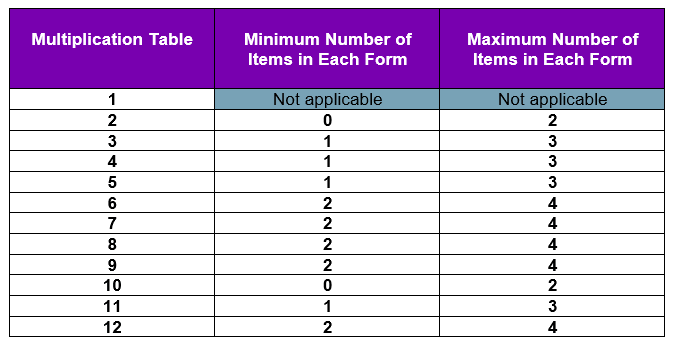Multiplication Tables Check - Getting the Best from Your Pupils
Estimated Reading Time - six minutes.
This blog piece thinks about how we can get the best out of our Year 4 pupils in the upcoming Multiplication Tables Check. This year is the first year that the check becomes statutory for all Year 4 pupils. This year the screening check takes place over the three-week period of Monday 6 June - Friday 24 June 2022. As this check is testing the fluent recall of pupil’s multiplication facts, it is important that our pupils are quick and accurate.
I have broken down my top four tips to support you as a teacher in this run up to the Multiplication Tables Check.
1. Identify Unknown Facts - Finding the Gaps
With the Multiplication Tables Check only a month away, I think that it is incredibly important that we focus our immediate attention on finding any specific multiplication table gaps that our pupils currently have. This is important as we may begin to fall into the trap of continuous testing with our pupils. It is important that we are aware that the children have a secure understanding of their multiplication tables and that they can recall these easily, however the more we test, the less time we have to teach. In finding immediate gaps we can focus our teaching on the unknown facts and can even begin to make a personalised approach for each pupil.
This table shows the weighting of questions from each multiplication in the check. We can see that there will be more questions from the 6, 7, 8, 9 and 12 multiplication tables because these have been determined to be the most difficult multiplication tables. For this reason, we might want to ensure that our pupils are most secure with these multiplication tables.

2. Provide Models and Images to Develop Visual Memory
Now that we have found the gaps in pupils’ knowledge it is important that we are able to fill these gaps. Although the Multiplication Tables Check is checking for pupils’ fluency, I think it is still important that pupils gain a deep conceptual understanding about multiplication. One of the ways to provide this is by using models and images to represent the multiplication tables. This should be approached in a skilful way with a clear rationale behind why any manipulative or representation is used. In the Education Endowment Foundations ‘Improving Mathematics in Key Stages Two and Three Guidance Report’ it states that teachers should “enable pupils to understand the links between the manipulatives and the mathematical ideas they represent. This requires teachers to encourage pupils to link the materials (and the actions performed on or with them) to the mathematics of the situation, to appreciate the limitations of concrete materials, and to develop related mathematical images, representations, and symbols.” (Education Endowment Foundation, 2017).
This idea is further discussed by NCETM with the use of representations “to expose the mathematical structure being taught” rather than objects to assist children in performing calculations which “may encourage a child to become dependent on them.” (NCETM, 2022).
With this in mind, a child that might be stuck on the multiplication fact 6x4, might already know 4x6. In this instance we may wish to use an array so that the child is able to see the commutative nature of multiplication. They may be able to see relationships between other multiplication facts, such as 6x4 is the same as 6x2 +6x2. We can see in exploring the multiplication tables using representations and manipulatives a stronger conceptual understanding will be built rather than learning tricks.
A good source for looking at the rationale of what manipulatives to use can be the White Rose calculation policy. One of the policies focuses directly on multiplication and division.
3. Strategies for Remembering Unknown Facts
There is always the occasion however when we need a quick trick to remember something. I still recite a rhyme whenever I spell ‘because’ in my head. I do not feel that this is the best way to learn the multiplication facts and it will certainly not give us deep conceptual understanding or allow us to make links and think about relationships with other multiplication tables. However, when we do have a block in our head a solution could be to use a rhyme such as ‘Six and eight are running late! How many minutes? Forty-eight! (6 x 8 = 48)’
A list of these rhymes can be found here. I feel that this needs to be used sparingly, but if this is what is needed to allow a pupil to overcome a hurdle and feel successful in maths, then this can be a necessary method. It is important that are pupils feel like they can achieve in maths, and we do want to do all that is in our power to relieve maths anxiety.
4. Regular Oral Practice for Times Tables in and out of Sequence
Although earlier I said that we want to focus mainly on the teaching of multiplication tables rather than the testing of multiplication tables, the use of low stake and regular quizzes can be useful. We should always use the ad hoc times to practice our retrieval of facts such as lining up to go to assembly or that spare minute before home time. We know that the regular retrieval of knowledge allows us to recall this more efficiently when we need this the most.
Bonus Tip!
My final bonus tip is to use the Practice Check and enable any Access Arrangements.
Although the Practice Check for the Multiplication Tables Check uses the same set of questions, and so is not useful as a test, it can be useful to allow pupils to see a preview of the check before sitting the official check. It is at this point pupils can explore how they will enter their answers, although research from the 2021 optional check suggests that in this type of timed assessment, Year 4 pupils may benefit from using a keyboard or a touchscreen rather than a mouse.
You may wish to explore Access Arrangements for specific children, one of which can be to add a pause button between questions. Although this does not give extra time to answer questions, it does allow pupils the time to stop thinking of the previous question before moving onto the next one.
If you would like to gain a clear understanding of The Multiplication Tables Check Assessment before administering it within the school then please click in the box below to purchase a pre-recorded webinar which you are able to view at any time.
If you wish to further develop your understanding of how you teach multiplication, you may wish to purchase the E-learning module ‘Developing Fluency in Multiplication Facts’, again please click in the box below.
About The Author
Jason is part of The Education People's Primary School Improvement Service, he is a specialist improvement advisor for maths. He worked as a teacher, working across the primary age range for eleven years, and spent six years as a key leader in a primary school focussing on the improvement of maths.
Jason is a Mastery Specialist for Kent and has supported schools in their own Mastery journey for the past six years.
He is passionate about ensuring the improvement of Maths teaching and learning for all children.



